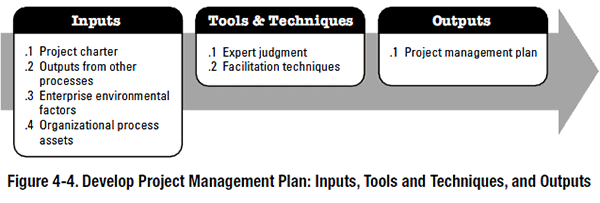
The difference between a successful project and an unsuccessful one can usually be narrowed down to one word: Planning. The Project Management Institute (PMI) reports that only 64% of projects meet their intended goals, and from my experience working for a large engineering company, this is probably not too far out.
But there is a solution. Even the smallest of projects can benefit from a Project Management Plan. As a minimum, if you learn how to write a strong project management plan you can trim it down to fit the size of the project.
If project management seems like a puzzle sometimes, the project management plan puts the pieces together into one coherent plan for one specific project. It serves to inform project stakeholders how the project will be managed and what methodology will be used to make decisions and deal with project issues.
From the PMBOK
The Project Management Body of Knowledge (PMBOK) contains a process called Develop Project Management Plan which is found within the Project Integration Management knowledge area in the planning process group. In summary,
PMBOK, 5th Edition, Section 4.2, “Develop Project Management Plan”
Develop Project Management Plan is the process of defining, preparing and coordinating all subsidiary plans and integrating them into a comprehensive project management plan. The key benefit of this process is a central document that defines the basis of all project work.
The inputs, tools & techniques, and outputs of the process are as follows:
Purpose
Project management plans are used to do the following things:
- Plan the project. The project manager must figure out who the project team is, how they will be organized, and what the project completion date will be, among other things.
- Guide the project manager’s decisions. When project issues arise, your first action should be to consult the project management plan. If there is no guidance there for that particular issue, consider putting it into the next one for the next project.
- Enlighten the project sponsor. This was one of the unexpected benefits when I first started writing project management plans. The project sponsor, who is normally the project manager’s boss in one form or another (whether in a different organization or within the same one, physically above the reporting structure or not) is informed about how the project will be managed. They are usually quite impressed when a project management plan is delivered to them and they form an excellent critical first impression of the project manager’s competence. A small caveat, though. Some items of the project management plan are not often inappropriate for the project sponsor, especially cost/profit information if the project manager is in a separate organization.
Criteria
The most important criteria is that they contain any information that is relevant to managing the project. That’s the point, to communicate how the project will be managed.
Audience
Project Management Plans can have multiple audiences.
- Project Manager. As a minimum the project management plan needs to be the repository for the official “project plan.” It organizes the project so that you, the project manager, can rapidly determine project information such as schedules and weekly updates, as well as seek guidance and direction during the project.
- Project Sponsor. The project management plan should be shared with the project sponsor. Often there is sensitive information like actual project costs contained within it, but the project sponsor can be issued an initial project management plan at the outset of the project, which usually does not contain sensitive information.
- Project Team. The project management plan can be used to share the schedule, budget, or other project information with the project team, who will feel valued from being given the information.
Template
I wish there were a standard template for a project management plan. Unfortunately, projects are by definition unique and there is no standard template.
Fortunately, unless you are performing a highly innovative, unique project, you are likely to share many similarities with other projects in your organization. This is the best source of project management plan content, and you should always start with a recent, similar project.
If you don’t already have a template for certain types of projects in your organization, maybe this is your cue to start one.
Sections
Here is my recommendation for the sections of a project management plan:
-
Introduction
Provide an overview of the project. Identify what the project is intended to accomplish, who the stakeholders are, and the success factors. Be as quantitative as possible with success factors. i.e. Is there a specific quality standard that can be attached? Is there a date that must be met? If there is a project charter, this is a good reference for what to include in this section.The critical success factors should be identified. In other words, what is the definition of project success? Deadlines and budgets are normally part of it, but don’t miss things like project sponsor approval, minimal change orders, low rate of rejections, etc.
-
Scope Statement
State what tasks and activities are part of the project and what are not. If the scope is not well defined in any area, this is probably a good time to define it, keeping in mind that the biggest cause of failed projects is confusion related to the project scope. Extra tasks cost money, and the stakeholders generally interpret any undefined areas in the scope in their own favor. For example, if the project scope for an interchange project does not define land purchasing, the owner will assume it is part of the project, and the engineer will probably assume it isn’t. Not that that would ever happen… -
Deliverables
All projects must have deliverables. These are the products or services that the project produces and “delivers” to the customer or client. They should be spelled out in detail within the project management plan, together with applicable details about their quality, length, size, or any other standards that apply.
-
Project Schedule
Since projects have a defined beginning and end, the schedule is extremely important. The project should be broken down into tasks (aka activities) to an appropriate level of detail. For small projects, this could be as simple as identifying deadline dates. Software could be used, such Microsoft Project. Sufficient allowances need to made for contingencies, and all stakeholders should be aware of the timelines involved. The Project Manager should be aware of the critical path at all times throughout the project, to be able to respond when critical issues arise. This is also a good place to identify the dates for the key project deliverables. The schedule itself can be placed in an appendix. -
Budget
Each task in the activity list should have an assigned budget. The total budgets should be rolled up into a total project budget. This allows for accurate project cost tracking, and earned value analysis to determine the status at any time. Potential for changes and adequate reasons can also be documented. -
Quality Management Plan
The quality success criteria of each phase of the project should be identified and specified to ensure compliance during project execution. Every industry has standard quality success criteria which can be looked up and specified for the project, like ASTM, IEEE, or ISO-9001. Provide a description of the processes that will be used to ensure that the quality of the product(s) meet the requirements. -
Human Resources Plan
The project participants should be identified and it should be ensured that these individuals have the time and capability to carry out the tasks required of them. -
Communication
Define what major communications will be made at what phases of the project, such as project review meetings. Define the communication strategy with key stakeholders, especially those inevitable stakeholders that have a minor financial interest but disproportionate impact on the project outcome (like the adjacent landowner mentioned above). -
Risk Management Plan
This is the place to identify and prioritize the risks to a successful project. The plan should list, in table form (or similar) each risk, the mitigation strategy, and the plan of action should that risk occur. Optionally each risk can also be prioritized and ranked for probability and severity (Risk = Probability x Severity). There is nothing more comforting than having a well thought out plan when something bad happens, therefore taking the extra time to be comprehensive is very important. PMI reports that this is one of the most underrated sections of the project management plan. -
Procurement Management Plan.
Many projects have sub-consultants, sub-contractors, and suppliers. The project management plan should identify at the outset what outside products and services are required, how they will be procured, and how their progress and quality will be monitored.
Good luck on your project management plans, and leave us a comment to let us know if you have any other ideas or experiences.







